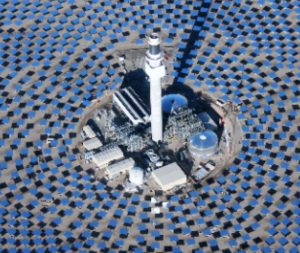Our Vision
Our Vision is the successful application of advanced, high-temperature molten salt technology as a thermal storage medium for large-scale solar energy systems.
The following is a brief summary of our approach, the need-basis for our effort, and our anticipated outcome:
Our Approach
- During the period of 2015-2016 the team, supported by our technical advisors and input from the industry, initiated and completed the following activities:
- Reviewed the specifications and lessons learned from previously built molten salt (MS) test loops and studied reports or publications of the system testing.
- Established the desired objectives for our test campaign with MS test loop. Our initial objectives included verifying the performance of a novel molten salt and evaluating the feasibility of an internally and/or externally insulated hot storage tank. Our additional objectives included, for example, measuring corrosion rates under flowing conditions, heat transfer rates, pressure drops, and other performance criteria.
- Developed the necessary design for the purpose of negotiating with the vendors and cost take-offs for our MS test loop, also capable of obtaining the required test data. Specified total salt inventory, flow rate, operating temperatures, heating and cooling requirements, and major equipment layout. Developed preliminary Process Flow Diagram (PFD) and Bill of Materials (BOM) of major equipment.
- Prepared a design document using novel high-temperature MS and high-temperature resistant material and instrumentation for flow and temperature measurement.
- Our objectives for 2017 and beyond: The team is focused on standing up our large-scale test loop in order to perform materials evaluation and obtain thermodynamic properties in a flowing MS fluid operational environment. The loop will have provisions for a future connection of the system’s hot leg to a secondary power conversion loop, a supercritical carbon dioxide (SCO2) Brayton Cycle loop. In addition, there will be a system modeling effort that will include integration with a future SCO2 Brayton Cycle loop.
- Our path to success: LC Energy Storage has assembled a world-class team and is continuing with its effort to stand up, for operational testing and subsequent scaling up to an industrial scale, a never designed and built before state-of-the-art proof-of-technology Demonstration Facility.
- Other relevant facts: Over the past years the team has been resourced by public and private funding. The team intends to follow the same approach for the next phase of our effort. The team’s anticipated cost estimate for the next phase of the project is modest and is well in line with past historical cost trends for efforts of similar nature.
The Need
Solar power is an environmentally clean form of electrical energy and a relatively new technology based on the use of molten salts, which provide us with a way to store energy, thus allows electrical power production at night or during cloud cover. Molten salt energy storage (MSES) based on nitrate salt is now being used on two solar plants within the United States, including the Solana Solar Generating Station at Gila Bend, Arizona, and the Crescent Dunes Solar Facility in Tonopah, Nevada.

MSES uses a mixture of sodium nitrate and potassium nitrate in a liquid form to store solar energy during the day. These nitrate salts are inexpensive; both chemicals are actually used commercially as fertilizer, so they are environmentally benign. At night, the stored heat from the hot salt is transferred to a steam Rankine cycle to produce electricity. This storage method has proven to be so beneficial that it will be used in further expansion of the Crescent Dunes power plant in Tonopah. They plan to increase power production from 110 megawatts of electricity to over 500 megawatts.
MSES technology is not limited to solar power applications. It can be expanded to include large-scale storage of heat generated by any high-temperature source. With the future development of high-temperature heat pumps, efficient storage of electrical energy is also possible.
MSES can be improved to decrease the costs of energy storage. Inexpensive chloride salts with a higher operating temperature than the nitrate salts now used promise to increase the efficiency of the conversion of stored heat into electricity. Higher temperatures also increase corrosion rates of steel components in the energy storage system; novel pipe coatings, as well as the use of refractory material for use in the hot salt tank, need to be investigated. To test the engineering solutions to these problems, and to address system issues arising from scaling up to a commercial-industrial size MSES operation, a testing facility is needed that combines high temperature-chloride salts with high-temperature resistant piping and joints materials, storage tank, pumping system, and measurement instrumentation. The proposed test facility is a first-of-a-kind as no such testing and proof-of-technology facility currently exists in the U.S.
THE OUTCOME
Design and construction of our High-Temperature MSES Testing Facility has begun. Our testing facility will be a collaborative project between universities and private industry. The team has been in discussions with a very experienced national industrial company with much experience in the field of complex system design, fabrication, and installation. The project will provide a valuable insight for scaling up to industrial scale operation and its associated estimated cost, and provide research resources to further molten salt energy storage technology for general thermal energy storage with future application to the storage of electrical energy. There will be job creations in both Nevada and Virginia.